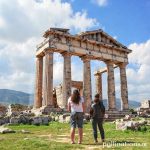Mexico, a land brimming with vibrant culture and rich history, offers a visual feast for photographers. Beyond its stunning landscapes and delicious cuisine, Mexico’s architecture stands out as a captivating subject. From colonial cities adorned with pastel facades to modern marvels reflecting indigenous influences, there’s an endless array of photographic opportunities for both amateur and professional photographers.
Photographing Mexico’s colorful architecture is more than just pointing and shooting. It’s about capturing the essence of a nation, its history, and its people. This guide will provide you with tips and insights to help you document the unique architectural beauty of Mexico, ensuring you return home with stunning images that tell a story.
Understanding Mexican Architectural Styles
Before you start snapping photos, it’s helpful to understand the different architectural styles you’ll encounter throughout Mexico. This knowledge will inform your approach and help you capture the nuances of each style.
Colonial Architecture
Dominating many historic city centers, colonial architecture is a blend of European styles adapted to the Mexican climate and local materials. Key features include:
- Vibrant Colors: Buildings are often painted in bright yellows, oranges, reds, and blues, reflecting the Mexican love for color.
- Courtyards: Inner courtyards provide shade and ventilation, featuring fountains, gardens, and intricate tilework.
- Arches and Balconies: These architectural elements add elegance and are often adorned with wrought iron details.
Indigenous Influences
Pre-Columbian civilizations like the Maya and Aztec left behind impressive architectural legacies. While many structures are ruins, their influence can still be seen in modern Mexican architecture. Look for:
- Geometric Patterns: Inspired by ancient designs, these patterns are often incorporated into facades and decorative elements.
- Use of Natural Materials: Stone, adobe, and wood are commonly used, reflecting a connection to the land.
- Pyramidal Structures: While mostly ancient ruins, the pyramidal form has influenced modern building designs.
Modern Mexican Architecture
Contemporary Mexican architecture blends modern design principles with traditional elements, creating unique and innovative structures. Pay attention to:
- Use of Concrete: Often textured and colored to blend with the landscape.
- Integration of Nature: Architects often incorporate gardens, patios, and natural light into their designs.
- Bold Forms and Shapes: Experimentation with unconventional shapes and structures is common.
Tips for Photographing Mexico’s Colorful Architecture
Now that you have a basic understanding of Mexican architectural styles, here are some practical tips for capturing stunning photos:
Timing is Everything
The best time to photograph architecture is during the golden hour – the hour after sunrise and the hour before sunset. The soft, warm light enhances colors and creates dramatic shadows, adding depth and dimension to your images. Avoid shooting during midday when the harsh sunlight can wash out colors and create unflattering shadows.
Composition Techniques
Experiment with different compositions to create visually appealing images. Consider these techniques:
- Rule of Thirds: Divide your frame into nine equal parts and place key elements along these lines or at the intersections.
- Leading Lines: Use roads, walls, or other lines to guide the viewer’s eye through the image.
- Symmetry: Capture the balance and harmony of symmetrical structures.
- Framing: Use natural elements like trees, arches, or doorways to frame your subject.
Pay Attention to Details
Don’t just focus on the overall structure; look for interesting details that add character and tell a story. Capture close-ups of intricate carvings, colorful tiles, wrought iron balconies, and other unique elements. These details can add depth and visual interest to your photographs.
Capture the Context
Show the relationship between the architecture and its surroundings. Include people, street scenes, and other elements that provide context and tell a story about the building’s place in the community. This will help viewers understand the building’s purpose and its cultural significance.
Use a Polarizing Filter
A polarizing filter can reduce glare and reflections on buildings, especially on sunny days. It can also enhance colors and increase contrast, resulting in richer, more vibrant images.
Consider Black and White
While Mexico is known for its vibrant colors, don’t overlook the power of black and white photography. Converting your images to black and white can emphasize the texture, form, and lines of the architecture, creating a timeless and dramatic effect.
Conclusion
Photographing Mexico’s colorful architecture is a rewarding experience that allows you to connect with the country’s rich history, culture, and artistic spirit. By understanding the different architectural styles, utilizing effective composition techniques, and paying attention to details, you can capture stunning images that showcase the beauty and diversity of Mexican architecture. So grab your camera, explore the vibrant streets of Mexico, and start documenting its architectural treasures.
If you enjoyed this article, don’t forget to explore more inspiring stories on Life in Mexico!
IMAGE: A vibrant street scene in San Miguel de Allende, Mexico, during golden hour. The colorful colonial buildings are bathed in warm light, with bougainvillea cascading from balconies. Cobblestone streets lead the eye towards a distant church. The mood is cheerful and inviting, capturing the essence of Mexican culture. Style: Travel photography, vibrant colors, golden hour lighting.


